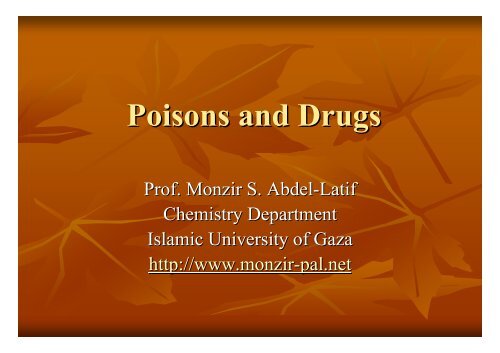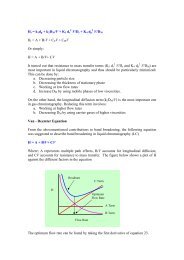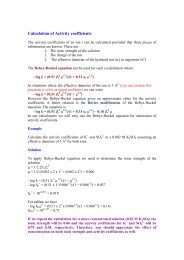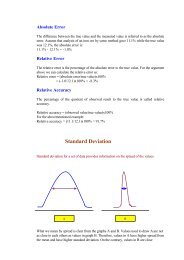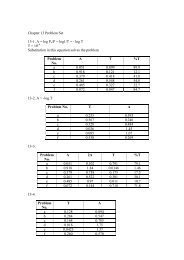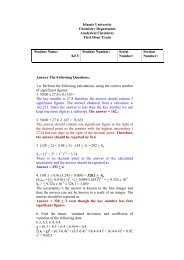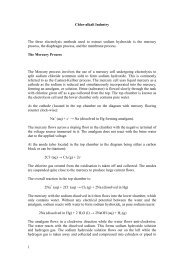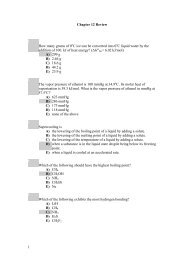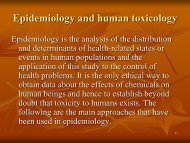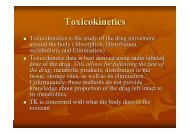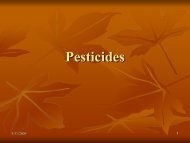Poisons and Drugs
Lecture1 pdf - Professor Monzir Abdel-Latif
Lecture1 pdf - Professor Monzir Abdel-Latif
You also want an ePaper? Increase the reach of your titles
YUMPU automatically turns print PDFs into web optimized ePapers that Google loves.
<strong>Poisons</strong> <strong>and</strong> <strong>Drugs</strong><br />
Prof. Monzir S. Abdel-Latif<br />
Chemistry Department<br />
Islamic University of Gaza<br />
http://www.monzir-pal.netpal.net
Syllabus<br />
In this course, it is anticipated to cover the following topics:<br />
1. Introduction to Toxicology<br />
2. Epidemiological Studies<br />
3. Toxicodynamics <strong>and</strong> Toxicokinetics<br />
4. Toxicokinetics ...... Continued<br />
5. Toxicokinetics ... continued<br />
6. Risk Assessment <strong>and</strong> Management<br />
7. Review of Analytical Methods<br />
8. Drug Testing Methodologies <strong>and</strong> Possible Pitfalls
Methods of Analysis<br />
1. Gas Chromatography<br />
2. Liquid chromatography<br />
3. Mass Spectrometry<br />
4. Hyphenated Techniques<br />
5. AAS <strong>and</strong> AES<br />
6. Spectrophotometry <strong>and</strong> Fluorometry<br />
Sample Preparation<br />
Classes of drugs <strong>and</strong> poisons<br />
1. According to site of action<br />
2. Grouping of drugs
Drug Classification:<br />
9. Amphetamines<br />
10. Lysergic acid <strong>and</strong> LSD<br />
11. Other Hallucination <strong>Drugs</strong><br />
12. Cannabis<br />
13. Opiates <strong>and</strong> Cocaine<br />
14. Therapeutic Drug Monitoring<br />
15. Pesticides<br />
16. Illicit <strong>Drugs</strong> Analyzed by the Forensic<br />
Lab in Gaza
We will follow presentation chapters from several<br />
textbooks including “Fundamantal<br />
Toxicology” by John<br />
Duffus <strong>and</strong> Howard Worth, published by RSC in 2006,<br />
Poisoning <strong>and</strong> Toxicology h<strong>and</strong>book, 4 th Ed., A Guide to<br />
Practical Toxicology, 2 nd Ed, Woolley, , Toxicological<br />
Chemistry <strong>and</strong> Biochemistry, 3 rd Ed., as well as others .<br />
However, other books in Instrumental Analysis <strong>and</strong> related<br />
research papers will be found very helpful.<br />
I’ll try to maintain a web page for the course <strong>and</strong> regularly<br />
post reading material for you to look at.
Introduction to Toxicology<br />
<br />
<br />
<br />
Toxicology is the fundamental science of poisons.<br />
A poison is a substance that can cause severe injury or<br />
death as a result of interaction with living tissue.<br />
Therefore, in principle, all chemicals can be considered as<br />
potential poisons causing injury or death upon excessive<br />
exposure. At the same time all chemicals can be regarded<br />
as safe if exposure to chemicals was kept below a tolerable<br />
limit.
Exposure to toxins<br />
Exposure is a function of the following factors:<br />
Amount or concentration of the target chemical<br />
Time of interaction of the chemical with the target organ<br />
Frequency of interaction of the chemical with the target<br />
organ<br />
Organ exposed<br />
For humans, age <strong>and</strong> health of the subject are also<br />
important factors<br />
For highly toxic chemicals, the tolerable exposure is close to<br />
zero
Determination of tolerable exposure<br />
In fact, this constitutes a problem since we do need<br />
reliable data relating exposure to injury or adverse<br />
effect in humans.<br />
Unfortunately, what can be considered as an injury or<br />
an adverse effect is not well defined <strong>and</strong> debatable.<br />
We will look at this problem later
Adverse effects<br />
An adverse effect can be defined as an abnormal,<br />
undesirable, or harmful change of people or<br />
organs following exposure to the potentially toxic<br />
substance<br />
Although the ultimate adverse effect is death, the<br />
following are definite adverse effects:<br />
Altered food consumption<br />
Altered body or organ weight<br />
Altered enzyme or hormone levels, ..etc
Harmful effects<br />
<br />
<br />
<br />
An effect is considered harmful if it causes a functional<br />
damage to an organ, irreversible change in homeostasis or<br />
increased susceptibility to chemical or biological stress<br />
including infectious diseases.<br />
One should consider the degree of alteration from<br />
normality <strong>and</strong> the relation of the altered property to the<br />
total well-being of the person<br />
In some cases, a person can adapt to the irreversible<br />
alteration <strong>and</strong> practice normal life
In some cases of immune reactions<br />
leading to allergy:<br />
The first exposure may not cause an adverse effect<br />
of allergy, however, it may sensitize the organism<br />
to respond adversely (badly) to future exposures<br />
even at lower levels
Amount of exposure<br />
The amount of exposure to a chemical that causes<br />
injury varies over a very wide range depending on<br />
the type of chemical <strong>and</strong> its form (liquid, solid, or<br />
gas)<br />
This can be quantified using the median lethal dose<br />
(LD 50 ) concept or lethal concentration LC 50
Median Lethal Dose (LD 50), mg toxin/kg<br />
body weight<br />
LD 50 is a statistically derived single dose of a<br />
chemical that can be expected to cause the death of<br />
50% of organisms of a given population, under a<br />
defined set of experimental conditions.<br />
LD 50 ‘s s when reported for human beings are<br />
obtained by extrapolation from studies on<br />
mammals, or observations following accidental or<br />
suicidal exposures.
The LD 50 is used to classify <strong>and</strong> compare toxicity of<br />
chemicals, although it is of limited merits. For example,<br />
the LD 50 classification orally to rats are:<br />
Very toxic<br />
less than 25 mg/kg<br />
Toxic from 25 -199 mg/kg<br />
Harmful from 200 - 2000 mg/kg<br />
<br />
However, it is not convincing to label a substance as toxic<br />
because its LD 50 is 199, while labeling another as harmful<br />
since its LD 50 is 200. That is why the LD 50 values need<br />
more refinements.
In addition, when using LD 50 values, there is no<br />
simple relationship between lethality <strong>and</strong> sub lethal<br />
toxic effects.<br />
In other words also, it is not informative to what is<br />
the minimum dose that can be lethal, <strong>and</strong> thus no<br />
indication of what can be considered a safe<br />
exposure level.
Toxicity versus Risk<br />
With regards to chemical safety, risk assessment<br />
can be more important than actual toxicity of<br />
chemicals.<br />
Risk can be regarded as the probability that a<br />
substance would impart unacceptable harm or<br />
unacceptable effects to an organ or to ecosystems<br />
upon exposure.
Safety<br />
<br />
<br />
<br />
It is possible to define safety as the practical certainty that<br />
injury will not (high probability) result from exposure to a<br />
hazard under defined conditions.<br />
Practical certainty is a numerically specified low risk (or<br />
socially acceptable risk).<br />
Assessment of risk depends on scientific data, but<br />
acceptability is influenced by social, economic, political<br />
<strong>and</strong> benefits arising from a chemical or a process.
Uncertainty (safety) factors<br />
A threshold of exposure above which an adverse<br />
effect can occur <strong>and</strong> below which no such effect is<br />
observed, is obtained from available data.<br />
The threshold of exposure is then divided by a<br />
factor (uncertainty or safety factor) to lower it to a<br />
new value that toxicologists can regard as safe<br />
beyond doubt.
US National Academy of Sciences safe drinking<br />
water committee proposed the following guidelines<br />
for selecting the safety factors, to be used with no<br />
observed effect level (NOEL) data.
Safety Factor Selection:<br />
1. An uncertainty (safety) factor of 10 is used when<br />
valid human data based on chronic exposure is<br />
available<br />
2. An uncertainty (safety) factor of 100 is used<br />
when human data is inconclusive or limited to<br />
acute exposure, but reliable data on animals is<br />
available<br />
3. An uncertainty (safety) factor of 1000 is used<br />
when no human data is available <strong>and</strong><br />
experimental animal data is limited
Exposure to potentially toxic substances<br />
Toxins can cause injury when they reach<br />
sensitive parts of an organism at a sufficiently<br />
high concentration.<br />
Exposure can occur through:<br />
1. Skin (dermal or percutaneous) ) Absorption<br />
2. Inhalation<br />
3. Ingestion
Skin absorption<br />
<br />
Among the chemicals that are absorbed through the skin<br />
are aniline, hydrogen cyanide, some steroid hormones,<br />
organic mercury compounds, nitrobenzene,<br />
organophosphate compounds <strong>and</strong> phenol. Some<br />
chemicals, such as phenol or methylmercury chloride, can<br />
be lethal if absorbed from a fairly small area (a few square<br />
centimeters) of skin. If protective clothing is being worn,<br />
it must be remembered that absorption through the skin of<br />
any chemical that gets inside the clothing will be even<br />
faster than through unprotected skin because the chemical<br />
cannot escape <strong>and</strong> contact is maintained over a longer<br />
time.
Inhalation<br />
Gases <strong>and</strong> vapors are easily inhaled but inhalation of<br />
particles depends upon their size <strong>and</strong> shape. The smaller<br />
the particle, the further into the respiratory tract it can go.<br />
Dusts with an effective aerodynamic diameter of between<br />
0.5 <strong>and</strong> 7 µm m can persist in the alveoli <strong>and</strong> respiratory<br />
bronchioles after deposition. Peak retention depends upon<br />
the aerodynamic shape but is mainly of those particles<br />
with an effective aerodynamic diameter of between 1 <strong>and</strong><br />
2 µm.
Physical irritation by dust particles or fibers can cause very<br />
serious adverse health effects but most effects depend<br />
upon the solids being dissolved. Special consideration<br />
should be given to asbestos fibers which may lodge in the<br />
lung <strong>and</strong> cause fibrosis <strong>and</strong> cancer even though they are<br />
mostly insoluble <strong>and</strong> therefore do not act like classical<br />
toxicants: care should also be taken in assessing possible<br />
harm from man-made made mineral fibers that have similar<br />
properties.<br />
Some insoluble particles such as asbestos, coal dust <strong>and</strong><br />
silica dust will readily cause fibrosis of the lung
Ingestion<br />
A chemical may accumulate if absorption exceeds<br />
excretion; this is particularly likely with substances<br />
that combine a fairly high degree of lipid solubility<br />
with chemical stability. Such chemicals are found<br />
in the group of persistent organic pollutants<br />
(POPS), including several organochlorine<br />
pesticides, which are now largely, but not entirely,<br />
banned from use
Divalent lead ions accumulate in bone where they<br />
replace the chemically similar calcium ions. While<br />
in the bone, they cause little harm but when bone<br />
breaks down, or during pregnancy or illness, the<br />
lead ions enter the blood <strong>and</strong> may poison the<br />
person who has accumulated them or, in the case<br />
of pregnancy, the unborn child.


